
Picture the scene: you’re in college, you’re working hard towards your degree, everything’s going as smoothly as you could hope.
And then boom — you’re assigned a group assignment.
“It’s okay,” you tell yourself. "Maybe it won’t be as hard as the last time.”
And you keep a tight grasp of that wide-eyed optimism for a full five minutes… before you’re thrown into a group chat with your newly appointed teammates.
And it all goes downhill from there.
From disagreements about font choices, to the sharing out of responsibilities, completing a project as a group is no easy task. No doubt there’ll be a mad last minute scramble, as you all join together in the common goal of not completing flunking the class.
The hard truth is that we humans are, at the best of times, a pretty chaotic bunch — especially when working in groups.
We’re more likely to succeed armed with a shared vision, a clear strategy and a roadmap of activities.

Whether we’re talking about college assignments or large-scale software development projects, the logic remains the same: a dynamic product roadmap can help teams stay on target, be accountable for tasks, and remain adaptive to change.
That, quite elegantly, leads us to the topic of this guide: technology roadmaps, also known as IT roadmaps.
If you’re responsible for development teams or any technology development project, this article will teach you what technology roadmaps are, why you’d want to use one, and how to create one of your own.
Ready to begin? Then grab your warm drink of choice, and let’s jump in.
What is a technology roadmap?
A wise man once said that a company is only as good as its technology.
And while this may have raised an eyebrow a few years ago, these are words to live by. In a world dominated by digital, businesses need a strong technological infrastructure to not survive — let alone thrive!
It’s here that a technology roadmap, sometimes known as an IT roadmap, is worth its weight in gold.
What is a technology roadmap
At a high level, a technology roadmap is a strategic plan which clearly lists all the technological initiatives being leveraged by a company. The roadmap lists not just which tech solutions are available to teams right now, but also those which will be coming up in the future.
Most importantly, a technology roadmap is a living document, meaning it’s reactive to the changing conditions of a business. For example, if one of your cloud-based service providers goes kaput overnight: your roadmap would need to change to reflect the search for (and implementation of) the new provider.
Technology roadmaps can be as in-depth as you want them to be, but they’re far more than a simple list of applications and IT solutions. In fact, the technology roadmap is often a useful way to track and align the overall strategic goals of a company.
As the needs of the business change to reflect its direction, so too will the IT roadmap. This ensures the technological infrastructure is always there to support.

That’s why your technology roadmap is far more than just a strategic plan — it’s something of a safety net, too.
Who can use a technology roadmap?
You’d be forgiven for assuming that technology roadmaps are only suitable for companies in highly technical industries. But in reality, they’re actually pretty handy for almost any business.
After all, with online sales in the US predicted to reach 4.8 trillion dollars by the year 2021, technology really needs to be at the heart of all modern businesses. And a technology roadmap essentially sets the stage for any of a company’s digital operations.
Whether it’s managing your customers and prospects with a CRM system, or deploying a new cloud-based email system to all employees — every one of these activities can (and should) be listed and prioritized on a your technology roadmap.
If you’ve ever had an employee ask when the next product update is due, or you’ve heard someone complaining that an internal system is slow or unreliable, a technology roadmap can definitely deliver value.

Not only will this roadmap be the source-of-truth for the current state of the company’s tech infrastructure, but it’ll also provide reassurance as to what’s coming in the future. It really is the best of both worlds.
Still not convinced that a technology roadmap could be a smart choice for your business? We hear you, and we’ve got a quick way to crack that particular nut.
Below you’ll see 3 simple questions relating to your company’s technology infrastructure. If you answer ‘yes’ to one or more of these questions, there’s no doubt that a technology roadmap could help you streamline your business operations and prioritize your internal teams’ workload.
1. Have you, or any member of your team, ever found it difficult to gain buy-in from executive or C-level colleagues? If the answer to this one is yes, a technology roadmap can help deliver practical, real-world rationale to tech investment decisions.
2. Has conflict ever arisen when it comes to prioritizing technological investment? When different teams have different priorities, it can be tough for them to see eye-to-eye. But a technology roadmap can give you the final word — and it’s tough to argue with hard data.
3. Are you lacking a means to manage the changing technological needs of your business? For example, if you’re still using local software when a cloud-based solution might be better, without a technology roadmap to highlight the age of your systems, the issue could fly under the radar.
What goes in an IT roadmap?
Now that you’re familiar with what technology roadmaps are and just how wide-ranging their use-cases can be, let’s dig a little deeper.
We’ll see some technology roadmap examples a little later in this guide, but for now, let’s start with the basics.
What exactly goes into an IT roadmap? Just like baking a cake, if you want to know how to develop a technology roadmap, you first need to know the ingredients.
Naturally, the precise detail of what’s included in the technology roadmap will differ from business to business, but there are some common factors which you’ll find in most IT roadmaps. Here are some of the key components of a solid tech roadmap:
Software updates
Release dates
Tech-focused business goals (e.g. CRM targets)
New IT infrastructure rollouts
Old IT infrastructure deprecation
Data migration
Disaster recovery plans
Compliance reviews
… and much more
Beyond these individual line-items, your roadmap also has another crucial job: to assign specific tasks related to these items, prioritize them, and set an owner for each one. Depending on your business, you might also want to provide cost estimates too. In fact, any additional detail can be beneficial when it comes to deciding the priority of the tasks on your roadmap — so it definitely pays to think outside the box.
When it comes to action items, your technology roadmap should always include next-steps for key stakeholders. Without these, progress can easily stall. So, to maintain your momentum, it’s essential to focus your roadmap on actionable steps.
You can do this in a number of different ways, but here are our suggestions for ensuring that your technology roadmap is truly actionable:
Business goals: One of the differentiating factors of a technology roadmap (as compared to an IT plan, for example), is that it’s aligned with long-term goals of the business. By including this alignment on the roadmap itself, all stakeholders will immediately know why a certain task has been included and what it brings to the company.
Regular status reports: This will hold stakeholders accountable to the tasks they’ve already been assigned, and keep all other teams in the loop.
Release milestones: When big changes happen within your technology roadmap — like the launch of a new IT system — it’s important to list these as milestones for all stakeholders to see.
Training sessions: New systems will always come with a learning curve, so adding a requirement for training sessions to your technology roadmap will ensure that all employees are familiar with the new systems when they go live.
Potential risks and roadblocks: Does your main competitor have a product launch on the horizon? It can be a good idea to have this listed on your technology roadmap so that teams can prepare for, or identify the reasons behind, any significant changes in business performance.
As you can see, provided you’re using your technology roadmap optimally, there’s really no limit to how fine-grain it can get. The beauty of a well-developed roadmap is that it can take care of the macro and micro views all at once — so you can see the overall status of your technology infrastructure or the fine detail.
Visualizing your technology roadmap: an IT roadmap template
Just like the map you’d use to get yourself from A to B in a car, a technology roadmap is a visual tool too.

Thinking about a problem can only get you so far, so your technology roadmap can be a game-changer when it comes to mapping out and making progress. Of course, how you visualize your roadmap also matters — and that’s where the views in a roadmapping tool like airfocus can come in handy.
Here are just a few ways you might want to bring your technology roadmap to life:
Timeline View: In some ways, technology roadmaps are about predicting the future. Visualizing a project’s technological requirements end-to-end with the Timeline View in airfocus will certainly help you feel like a fortune-teller. By breaking down your roadmap by day, week, or month using a traditional Gantt chart, you can see exactly when things need to happen — and make task adjustments to ensure they get done.
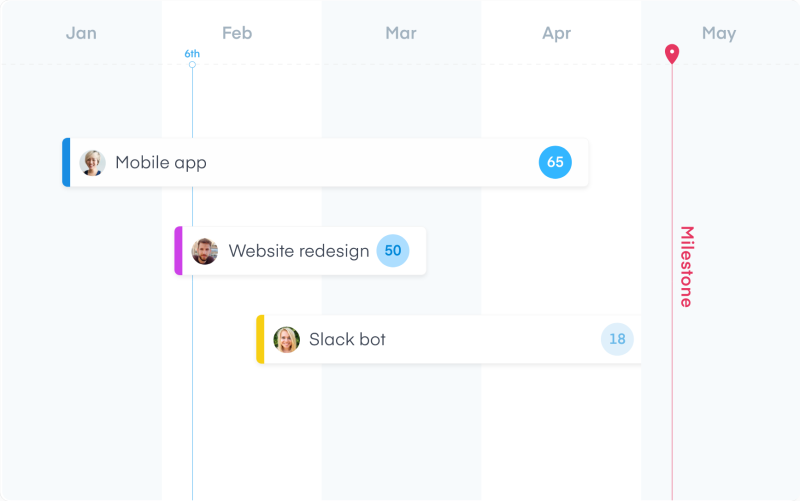
Board View: Some projects operate on more of a macro scale, meaning the day-to-day detail matters less than the bigger picture. In these cases, you’ll benefit from the Board View, which allows you to view the priorities of your IT operations based on what needs to happen in the long-term, short-term, or right now.
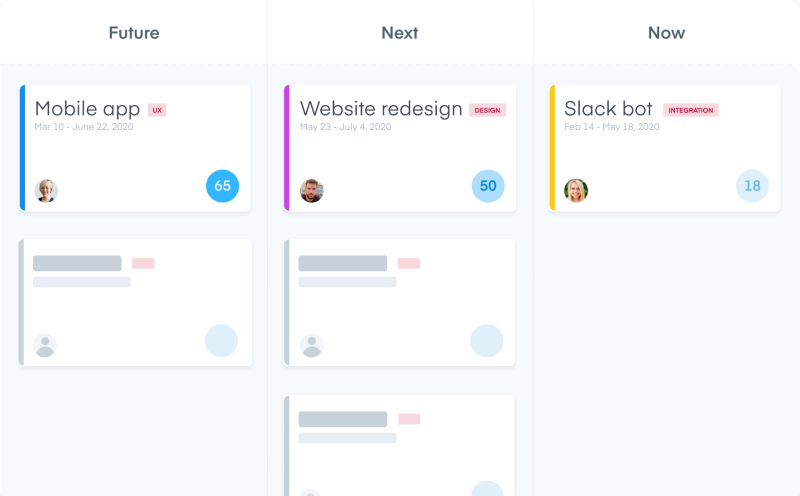
Chart View: If you’re more focused on the categorization of individual tasks than specific timelines, the Chart View is certain to come in very handy. By showing you important buckets, like “high priority” or “low value”, then assigning individual tasks to each section of the chart as colored circles, you’ll be able to get an instant view of your tech roadmap’s priorities in a few clicks.
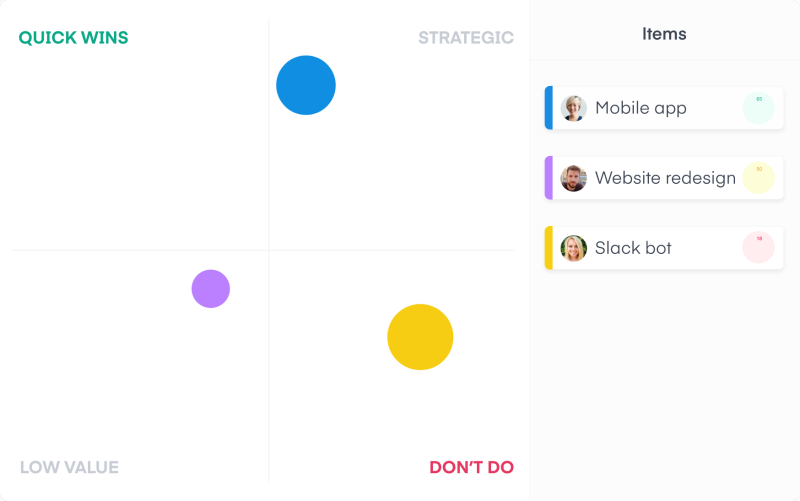
Item View: Sometimes you just need to zoom right in and look at the detail — and that’s exactly what the airfocus Item View helps you do. Essentially a prioritized list of all outstanding tasks on your technology roadmap, you can use this view to sort and filter by various criteria like Value, Effort, and Risk. By prioritizing each task against your project’s overall strategic goals, you can easily see what’s driving value (and what isn’t).
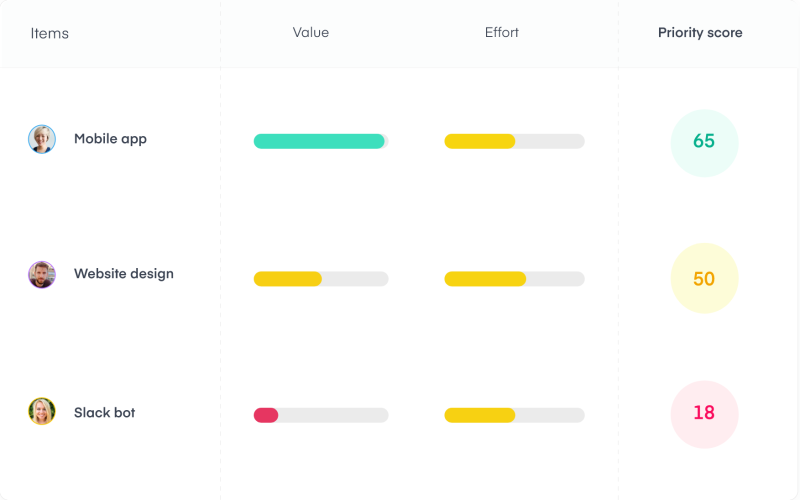
Not all roadmaps are created equal
While the central purpose of a technology roadmap remains the same from business to business, that doesn’t mean that all roadmaps are created equal. In fact, there are many different ways you can use a technology roadmap to bring teams together to work towards a common goal. That goal might be a business objective, a development goal, or an infrastructural milestone
Sometimes the best way to make a point is with an example — so let’s do exactly that.
Below we’ll share three different technology roadmap examples to help get your creative juices flowing.
IT roadmap
It goes without saying that most modern businesses are built on a foundation of IT infrastructure.
Whether that’s the hardware staff use to do their jobs, or the cloud-based software solutions used to manage communications, productivity, and so on — it’s all part of that IT infrastructure.
But managing these interwoven IT systems can become a pretty huge task, especially when a company experiences rapid growth. The solution is simple: deploy an IT roadmap.
You might understandably assume that an IT roadmap would be a simple list of software and hardware deployments set along a timeline, and you’d be half right.
The role of an IT roadmap
It’s true that a good IT roadmap delivers insights into the current state of IT infrastructure as well as upgrade paths, but there’s another key aspect which sets an IT roadmap apart — and that’s business goal alignment. At the heart of any roadmap lies a certain goal or objective tied to the overall success of the company.
Just like marketing or product development, a company’s IT systems play a part in the achievement of these goals. For that reason, a good IT roadmap will always align with the wider business objectives of the company, so the question should always be: “How does this IT initiative help the business achieve its goals?”
Development roadmap
If you manage, or are part of, a development team using the agile methodology, you’ll know exactly how important a roadmap can be. In fact, without a roadmap, it can be almost impossible to get anything constructive done at all.
That’s why a development roadmap can be such a powerful tool. Similar in nature to a product backlog, but on a more macro scale, a development roadmap can be a huge asset to product owners or managers.
The role of an development roadmap
In a nutshell, a development roadmap allows you to plan out the upcoming year — usually broken down by sprints if you’re using agile — and prioritize the tasks accordingly. You can break down the categories of development in a way that’s most logical for you and your team workflows, but the logic remains the same: your development roadmap lists key project milestones and when they should be hit.
Using a tool such as the Timeline View in airfocus allows you to gain instant oversight of your development process — just zoom out and see the year ahead broken down into quarters, months, or weeks.
You and your team leads can then begin to shuffle your priorities according to current development progress. Remember, your development roadmap is a living, breathing document which reacts dynamically to the conditions of the business and the progress of its projects.
Software roadmap
Have you ever stopped to consider just how many applications your company relies upon at any one time? In the age of cloud-based SaaS products, this can number into the tens or hundreds pretty quickly — and managing that is no mean feat.
It may seem simple, but every new tool a business uses requires staff training, an update plan, data migration from previous systems... the list goes on and on. If this sounds like a headache, you’re not wrong; but with a software roadmap, you can relieve that stress and become the master of your company’s software solutions.
The role of a software roadmap
A software roadmap can be an invaluable tool when it comes to juggling your software solutions, not least because each one demands a surprising amount of time and attention. With a solid software roadmap in place, you can eliminate the element of surprise.
For example, let’s imagine that you’re sunsetting your existing CRM system and bringing in a new one. There’s no doubt this is a gargantuan task, but — thanks to your software roadmap — you can break this big task down into little ones, and assign them to swim-lanes and stakeholders. Suddenly, a huge software migration doesn’t seem like such an overwhelming idea. It’s like the old saying goes: the best way to eat an elephant is one bite at a time. (Yeah, we’re not sure where that one came from, either).
Remember: every company is different, so no two technology roadmaps will be the same.

Funnily enough, the same also goes for technology roadmap platforms — so let’s take a closer look at what’s available on the market today.
Choosing the right technology roadmap software
airfocus
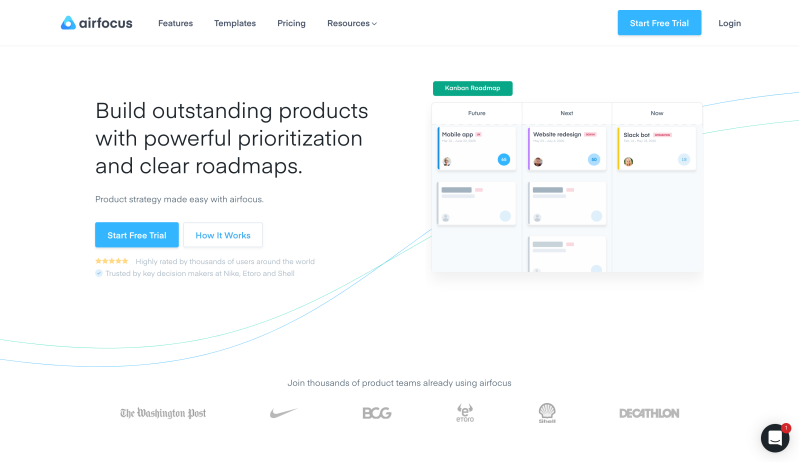
Created in Hamburg, Germany, by a group of friends with a true passion for both technology and the burgeoning SaaS industry, airfocus has grown quickly to become a leader in the strategic roadmapping space.
We’re sure you already know plenty about the airfocus platform, but just for the sake of clarity, here are the headlines:
Prioritization and progress tracking
Designed specifically for SMEs and freelancers
Collaborative tools
Milestone tracking
User task assignment and action management
Powerful view options including Kanban and Gantt
Drag-and-drop functionality
Multiple chart views for cross-dimensional analysis
Proprietary algorithms to rate and prioritize your tasks
Full integration with third-party apps like Asana, Jira, and Trello
Countless one-click templates to help you get things done faster
Web app plus iOS and Android mobile apps
Starting from $29/month
In addition to this core set of features, the team at airfocus understands that, in order for a roadmapping tool to be engaging, it actually needs to be fun to use.
That’s why we’re constantly adding features which we think make roadmap planning — dare we say it — enjoyable.
Don’t believe us? How about our unique “Priority Poker” tool? This is a fun — but super effective — way to prioritize your outstanding tasks, by inviting subject-matter experts to collaborate and share their expertise in an all-new way.
How to create a technology roadmap with airfocus
Now that you’re a technology roadmap aficionado, we’re sure you’re eager to dip your toe in the water. So why not give it a try for yourself with our free Technology Roadmap and Prioritization Template?
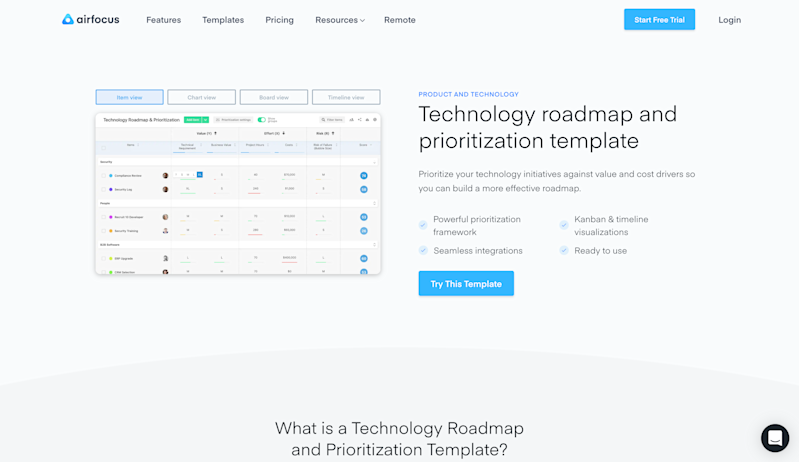
With this powerful template, you’ll be just moments away from leveling up your technological decision-making.
Getting started is easy, just follow these simple steps:
1. First up, log in to airfocus as normal and apply the template you found at the link above. We built this template to be totally flexible, meaning you can use it right out of the box or tweak any aspect to truly make it your own. Whether you want to use it to track the lifecycle of your critical IT systems, or simply plot the upgrade path for your CRM software, it’s all possible with this powerful template.

2. Let’s assume you want to customize this technology roadmap template to make it a little more ‘you’. That’s easy-peasy. The first thing to do is to begin adding any outstanding tasks or trackable events using the ‘Add item’ button at the top. You’ll also be asked to assign factor scores for each item.

3. Once you’ve added each item to your technology roadmap, airfocus will set to work reviewing each one and assigning a score. It’s this data that will inform the layout of your roadmap once the platform has crunched all the numbers.
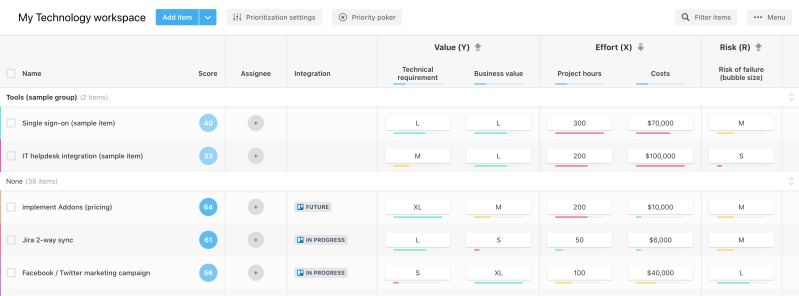
4. Next up, it’s time to start visualizing your roadmap. Just as we mentioned in the relevant section earlier in this guide, you can view your tasks in the way that suits you best: Timeline, Board, Chart, or Item view.

5. At this point, all of your individual tasks should be added and your technology roadmap should be looking pretty sharp. But what if a member of your team prefers to visualize the data differently? Not a problem. With airfocus, stakeholders can switch their personal view anytime. You can even enable or disable views on a per-user basis for the ultimate control of your roadmap.
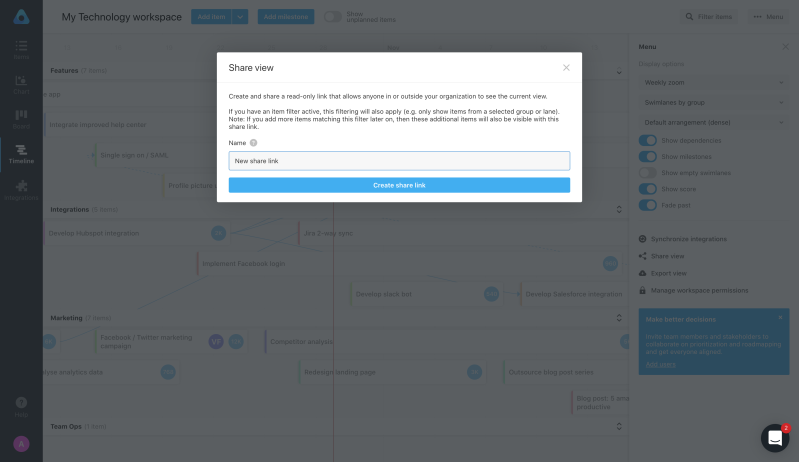
And that’s all there is to it! You now have a flexible, powerful visualization of your entire technology roadmap, and all in just a few minutes.
Don’t forget that, while our templates are pretty cool, there’s no limit to what you can achieve when you really dig into the airfocus feature set.
If your business has been looking for a way to organize your IT infrastructure, align your cross-team goals, and ensure everyone’s pulling in the same direction — a technology roadmap might be just the ticket.
But don’t take our word for it: try the Technology Roadmap and discover for yourself exactly why airfocus is the platform-of-choice for countless tech professionals across the world.
Happy mapping!

Malte Scholz

Read also

Build great roadmaps

Experience the new way of doing product management







